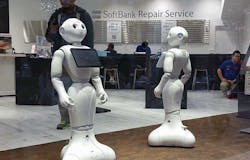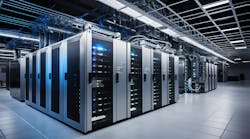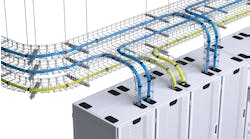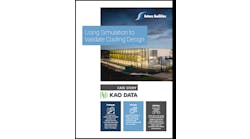Industrial Internet of Things and the Data Center
In this week’s Voices of the Industry, Shay Demmons, EVP and General Manager of the RunSmart software division at BASELAYER, explains the ins and outs of the Industrial Internet of Things and its potential to change and benefit the data center.
Shay Demmons, EVP and General Manager of the RunSmart software division at BASELAYER
You’ve heard a lot about the Internet of Things and how mountains of data will soon overwhelm your servers, networks, and data centers. Numbers like 50 billion+ connected devices have been thrown around, causing many to wonder how all these devices with all their data will be accommodated once connected to the Internet. Like road construction of our freeways, bridges and toll ways, we will no doubt need to add more “lanes” of capacity to our data centers as more data crosses the network each year. The tsunami of data, with all these new connected devices, is no doubt coming. Data centers will be called upon to increase their capacity by increasing data pipes and the density of servers to make greater use of existing resources. They will also need to become more efficient and autonomous to maintain a high standard of reliability and uptime. Servers and routers will need to be more carefully monitored for available space and capacity. Capacity planning tools, inventory management systems, and electronically enabled power and cooling systems will all need to be optimized or upgraded to achieve higher output and efficiencies.
Why More Data Now?
Electronic and physical devices are now capable of generating massive amounts of information, quickly. This data may be critical in life-saving situations such as medical equipment in a hospital or military devices and applications on a battlefield. Data has become the lifeblood of modern society. It is an inescapable reality of the connected world that we live in. Data also comes from everyday “things.” Many consumer devices such as appliances, wearables, and automobiles generate all kinds of data including status, warnings, sensors, fitness data and on and on. Consumer data can be combined to provide peer feedback, analyze buying patterns or deliver a better shopping experience. The application of data analytics is limitless.
The ability to quickly analyze data is also another key reason why data has become so much more useful in recent years. Software applications (databases, data analytics, etc.) are now capable of powerful mining results from once dormant data. They can spot trends, identify shortages and help manage inventory and capacity. The surge in devices capable of generating data along with software that can analyze it is creating the massive uptick in connected devices. We are just scratching the surface when it comes to applying data to every aspect of our lives.
The Internet of Things
The expansion of broadband connectivity over the past five years has enabled millions of devices to communicate data more easily and more frequently across the Internet. When we think of the Internet of Things, we think of automobiles communicating with satellites or smartphones running a health app or any other consumer device that is communicating across the Internet. The combination of fast data pipes with data-enabled devices, coupled with the ability to analyze data quickly is the catalyst for this massive revolution in computing.
The Industrial Internet of Things
The Industrial Internet of Things (IIoT) is the concept of utilizing sensor technology to communicate the status of devices in commercial or industrial facilities. Many devices have been data enabled for some years, but monitoring tools have not been deployed to extract and interpret the data. Each passing year brings more Internet-enabled devices and more technology to communicate with these devices. IIoT also employs the latest sensors in modern robot-operated factories, for example.
These devices can communicate with each other through various protocols or to infrastructure management systems. The principle is the same, whether its IoT or IIoT, where data is gathered and consolidated from devices to be analyzed and acted upon. The simple truth is that machines can crunch data far easier and faster than humans. Automation through software is here to stay.
The Industrial Internet of Things (IIoT) is the concept of utilizing sensor technology to communicate the status of devices in commercial or industrial facilities.
Devices are self-monitoring, self-healing, self-adapting, and self-improving.
Machine learning holds the promise that devices will become more accurate as they coordinate and cooperate with other devices. Machine learning implies that devices will adjust themselves and improve efficiencies by themselves with data inputs. Data will drive the adjustments that our machines will make. In the case of a data center, this learning will be around power and cooling, capacity planning, and so on. IIoT incorporates machine learning and big data using sensor data, machine-to-machine communications, and automation technology. Smart machines are better at gathering and assimilating data than humans. They can do it quickly and consistently which allows companies to spot inefficiencies in physical equipment and helps avoid downtime.
What the Market is saying about IIoT
The IIoT market is set to dwarf IoT by 10 to 1, perhaps 100 billion industrial devices according to PWC. This is because there are multiple sensors on many pieces of machinery in hundreds of thousands of factories scattered around the world. Data from a multitude of sensors will require more data center capacity than currently available. The good news is that these trends do not occur overnight, but they will occur more quickly than past disruptions in the human evolution.
[clickToTweet tweet=”Machine learning holds the promise that devices will become more accurate as they coordinate with other devices. ” quote=”Machine learning holds the promise that devices will become more accurate as they coordinate with other devices. “]
Some projections say that the North American market for IIoT related spending will reach up to $599B with a CAGR of 13.1%. The European IIoT market will be the highest with $629B and a CAGR of 11.9%. The leading IIoT segments, in healthcare, will reach $338B, with a CAGR of 10.5%. The market for artificial intelligence in IIoT, Teleoperation, and Tele-robotics will reach $19B by 2021. The APAC IIoT market CAGR will be 14.4% with smart factory deployments in China and India leading the charge.[1] Gartner predicts that spending on new IoT hardware exceeded $2.5 million per minute in 2016 and that, by 2021, one million IoT devices will be purchased and installed every single hour.[2] The pace of expenditures is unlike anything we have seen since the introduction of the Internet.
Preparing Your Data Center for IIoT
With a better understanding of the reality, impact and market size of IIoT let’s consider some steps that data center operators can take to begin their preparations for IIoT. Like any infrastructure upgrade, you must assess the current state. It’s not hard to tell that our physical freeways and bridges are in need of repair and upgrade. The data center may be more difficult to assess but will also need some upgrades to identify and monitor unused compute, available bandwidth and storage capacity.
There are two areas of IIoT that data center operators will need to consider in their preparations. The first area is readying the data center for the influx of data created by IIoT devices in general, all industrial consumption. These are all the external devices (consumer and industrial) that will push traffic through the data center. This is a capacity planning issue. Does your data center have enough bandwidth to handle the flow of all the data that will come through the infrastructure? A clear idea of available capacity (power, cooling, servers, routers, data pipes) is the first hurdle that needs to be cleared.
The data center infrastructure management software comes into play. Smart tools will be critical to electronically round up all the hardware and understand your current capacity. Tools will be needed that bring infrastructure, IT and external information together to optimize the entire flow of data while removing the clutter so operators can see what’s important. A DCIM Solution will provide real-time capacity monitoring, trending, forecasting, and “what-if” scenarios to move from capacity planning to capacity management.
[clickToTweet tweet=”Shay Demmons – #datacenters can be the model of IIoT success” quote=”Shay Demmons – #datacenters can be the model of IIoT success”]
The second area for data center operators to consider regarding IIoT is how to employ IIoT technology to improve operations in the data center itself. Because the data center has so many sensors attached to physical devices, it is an ideal candidate to utilize the capabilities of IIoT. IIoT promises to help data centers operate more efficiently at lower cost, with higher availability. Indeed, data centers can be the model of IIoT success for other manufacturing facilities since they will most likely lead the IIoT charge. The IIoT is likely to bring considerable changes to datacenters, but at a hefty benefit to the facilities in the long run.
Shay Demmons is EVP and General Manager of the RunSmart software division at BASELAYER.
References
[1] Industrial Internet of Things (IIoT): Market Opportunities for Solutions, Products, and Services 2016 – 2021, www.mindcommerce.com
[2] Gartner, “Top Strategic Predictions for 2016 and Beyond: The Future Is a Digital Thing”, 2 October 2015.
This is was one of the most popular Voices of the Industry columns on Data Center Frontier over the past four months. We will be highlighting additional top-read stories over the next few weeks. This article was originally published on Data Center Frontier on Aug. 14.





